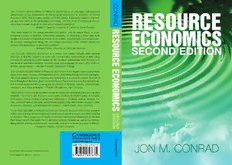
Resource Economics PDF
Preview Resource Economics
C o “Jon Conrad’s second edition of Resource Economics is an articulate, well-organized n presentation of key applications of intertemporal economics to problems of natural ResouRce r resources. More than a routine update of the first edition, it admirably balances theoreti- cal rigor and clarity in the presentation of models, with the kinds of institutional discus- a sions that motivate students to think about research questions.” d – robert T. deacon, University of California, Santa Barbara R “This book builds on the already-excellent first edition, with its unique focus on com- economics putational solution of dynamic optimization problems, by providing a richer and more e detailed discussion of theoretical models of renewable, nonrenewable, and environmen- s tal resource management along with very helpful discussion of the intuition behind the models and applications to resource problems.” o – anthony Fisher, University of California, Berkeley Second edition u “Jon Conrad’s Resource Economics is a unique and indeed indispensable learning R resource. It teaches students to work with sophisticated mathematical models using c a hands-on, intuitive approach based on the standard spreadsheet tools that are now pervasive in quantitative analysis. Conrad’s book sets a standard to which other textbook e authors should aspire.” – richard Howarth, Dartmouth College e “Jon Conrad’s second edition of Resource Economics is an elegant mathematical treat- ment of the many complex management issues confronting natural resource managers. c The book presents dynamic modeling and optimization in a practical context. The use of o Excel throughout the book gives it a concreteness that is lost in purely theoretical texts. It is an ideal advanced text covering the economics of fisheries, forestry, nonrenewable n resources, and stock pollutants.” – robert Mendelsohn, Yale University o “Resource Economics is an excellent choice for advanced undergraduates and master’s m students. The book’s use of Excel’s solver gives students an intuitive grasp of dynamic optimization without relying on advanced mathematics. Students analyze fisheries, for- i ests, and fossil fuels as they learn spreadsheet programming skills that are valuable in other c economics, business, and management courses.” – Martin Smith, Duke University s “I wish there had been a textbook such as Jon Conrad’s Resource Economics available when I was a young student beginning to learn about natural resource and environmental eS economics. This is a rigorous but highly accessible mathematical introduction to the field de that brings home to the reader the fundamental common threads, as well as the differen- ic t o tiating factors, among nonrenewable, renewable, and environmental resource problems.” i on – robert n. Stavins, Harvard University nd Jon M. Conrad Cover Photo © rozdesign | dreamstime.com Cover design by James F. Brisson ResourceEconomics,SecondEdition ResourceEconomicsisatextforstudentswithabackgroundincalculus andintermediatemicroeconomicsandafamiliaritywiththespreadsheet program Excel. The book covers basic concepts (Chapter 1); shows how to set up spreadsheets to solve simple dynamic allocation prob- lems (Chapter 2); and presents economic models for fisheries, forestry, nonrenewableresources,andstockpollutants(Chapters3–6).Chapter7 examines the maximin utility criterion when the utility of a generation dependsonconsumptionofamanufacturedgood,harvestfromarenew- able resource, or extraction from a nonrenewable resource. Within the text,numericalexamplesareposedandsolvedusingExcel’sSolver.Exer- cisesareincludedattheendofeachchapter.Theseproblemshelptomake conceptsoperational,developeconomicintuition,andserveasabridgeto thestudyofreal-worldproblemsinresourcemanagement. JonM.ConradisProfessorofResourceEconomicsintheDepartmentof AppliedEconomicsandManagementatCornellUniversity.Hetaughtat theUniversityofMassachusetts,Amherst,from1973to1977,joiningthe Cornellfacultyin1978.Hisresearchinterestsfocusontheuseofdynamic optimizationtechniquestomanagenaturalresourcesandenvironmental quality. He has published articles in the Journal of Political Economy, the Quarterly Journal of Economics, the American Journal of Agricul- turalEconomics,theCanadianJournalofEconomics,LandEconomics, MarineResourceEconomics,Biomathematics,EcologicalEconomics,Nat- uralResourceModeling,andtheJournalofEnvironmentalEconomicsand Management,whereheservedasanAssociateEditor.Heiscoauthor,with ColinClark,ofthetextNaturalResourceEconomics:NotesandProblems (CambridgeUniversityPress,1987)andispastPresidentoftheResource ModelingAssociation.CambridgepublishedthefirsteditionofResource Economicsin1999. Resource Economics SecondEdition JON M. CONRAD CornellUniversity cambridge university press Cambridge,NewYork,Melbourne,Madrid,CapeTown,Singapore, SãoPaulo,Delhi,Dubai,Tokyo,MexicoCity CambridgeUniversityPress 32AvenueoftheAmericas,NewYork,NY10013-2473,USA www.cambridge.org Informationonthistitle:www.cambridge.org/9780521697675 ©JonM.Conrad1999,2010 Thispublicationisincopyright.Subjecttostatutoryexception andtotheprovisionsofrelevantcollectivelicensingagreements, noreproductionofanypartmaytakeplacewithoutthewritten permissionofCambridgeUniversityPress. Firstpublished1999 Secondedition2010 PrintedintheUnitedStatesofAmerica AcatalogrecordforthispublicationisavailablefromtheBritishLibrary. LibraryofCongressCataloginginPublicationdata Conrad,JonM. Resourceeconomics/JonM.Conrad.–2nded. p. cm. Includesbibliographicalreferencesandindex. ISBN978-0-521-87495-3–ISBN978-0-521-69767-5(pbk.) 1. Naturalresources–Management–Mathematicalmodels. 2. Resourceallocation–Mathematicalmodels. I. Title. HC59.15.C6562010 333.7–dc22 2010014626 ISBN978-0-521-87495-3Hardback ISBN978-0-521-69767-5Paperback CambridgeUniversityPresshasnoresponsibilityforthepersistenceor accuracyofURLsforexternalorthird-partyInternetWebsitesreferredtoin thispublicationanddoesnotguaranteethatanycontentonsuchWebsitesis, orwillremain,accurateorappropriate. The first edition of this text was dedicated to my wife, Janice, and our sons, Andrew and Benjamin (a.k.a. Benj). This second editionisdedicatedtoourgrandchildren,GradyandMcKenna. Contents PrefacetotheSecondEdition:WhatStayed,WhatWent, What’sNew? pagexi Acknowledgments xiii 1 BasicConcepts 1 1.0 Renewable,Nonrenewable,andEnvironmental Resources 1 1.1 PopulationDynamics:Simulation,SteadyState,and LocalStability 5 1.2 ExtractionofaNonrenewableResource 10 1.3 Discounting 11 1.4 ADiscrete-TimeExtensionoftheMethodof LagrangeMultipliers 17 1.5 AsymptoticDepletionofaNonrenewableResource 25 1.6 TheMaximumPrincipleandDynamicProgramming inDiscreteTime 26 1.7 DynamicProgramminginaTwo-Period, Two-StateModel 30 1.8 AMarkovDecisionModelandStochasticDynamic Programming 32 1.9 Exercises 34 2 SolvingNumericalAllocationProblemsUsing Excel’sSolver 41 2.0 IntroductionandOverview 41 vii viii Contents 2.1 OptimalRotationforanEven-AgedForest 42 2.2 SolvinganImplicitEquationfortheOptimal Steady-StateFishStock 45 2.3 SolvinganImplicitEquationfortheOptimalDate ofExhaustion 47 2.4 OptimalFirst-PeriodHarvestinaTwo-Period, Two-StateModel 47 2.5 TheOptimalLinearHarvestPolicy 50 2.6 OptimalEscapementinaFinite-Horizon DeterministicModel 52 2.7 OptimalEscapementforOneRealization (Seed1)ofZt+1 53 2.8 AnOptimalDepletionProblem:TheMine Manager’sProblem 55 2.9 ApproximatingtheAsymptoticApproachtoa BioeconomicOptimum 58 2.10 TheMostRapidApproachPathtoanOptimal PollutionStock 63 2.11 OptimalEscapementwithStochasticGrowth 67 2.12 Exercises 69 3 TheEconomicsofFisheries 75 3.0 IntroductionandOverview 75 3.1 NetGrowth 76 3.2 FisheryProductionFunctions 79 3.3 TheYield-EffortFunction 82 3.4 TheStaticModelofOpenAccess 84 3.5 TheDynamicModelofOpenAccess 85 3.6 RegulatedOpenAccess 90 3.7 MaximizationofStaticRent 95 3.8 Present-ValueMaximization 97 3.9 TraditionalManagementPolicies 102 3.10 BioeconomicorIncentive-BasedManagement Policies 105 3.11 MarineReserves 120 3.12 Exercises 126 Contents ix 4 TheEconomicsofForestry 132 4.0 IntroductionandOverview 132 4.1 TheVolumeFunctionandMeanAnnualIncrement 133 4.2 TheOptimalSingleRotation 135 4.3 TheFaustmannRotation 136 4.4 AnExample 139 4.5 TimberSupply 143 4.6 TheOptimalStockofOld-GrowthForest 146 4.7 Exercises 149 5 TheEconomicsofNonrenewableResources 153 5.0 IntroductionandOverview 153 5.1 ASimpleModel 154 5.2 Hotelling’sRule 156 5.3 TheInverseDemandCurve 157 5.4 ExtractionandPricePathsintheCompetitive Industry 159 5.5 ExtractionandPricePathsunderMonopoly 164 5.6 Reserve-DependentCosts 167 5.7 Exploration 171 5.8 TheEconomicMeasureofScarcity 176 5.9 APostscriptto“BettingthePlanet” 195 5.10 Exercises 196 6 StockPollutants 200 6.0 IntroductionandOverview 200 6.1 TheCommodity-ResidualTransformationFrontier 202 6.2 DamageFunctionsandWelfare 204 6.3 ADegradableStockPollutant 207 6.4 DiffusionandaNondegradableStockPollutant 212 6.5 OptimalExtractionwithaNondegradableWaste 220 6.6 ClimateChange 223 6.7 EmissionTaxesandMarketablePollutionPermits 229 6.8 Exercises 238
